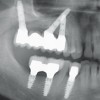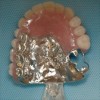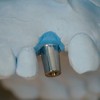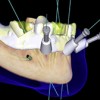The key to restoration of speech with an obturator prosthesis is a clear understanding of the anatomy and mechanisms associated with velopharyngeal function. This program details the anatomy of the area and the mechanisms allowing velopharyngeal closure to be accomplished.
Maxillofacial Prosthetics – Speech and Velopharyngeal function — Course Transcript
- 1. 19. Speech, Velopharyngeal Function Sal Esposito DMD, FICD Jana Rieger, PhD John Beumer III, DDS, MS*The material in this program of instruction is protected by copyright ©. Nopart of this program of instruction may be reproduced, recorded, ortransmitted by any means, electronic,digital, photographic, mechanical etc.or by any information storage or retrieval system, without prior permission.
- 2. Speech Mechanism No organs in the human body are solely responsible for the production of speech. It is a combination of the upper digestive and respiratory tracts working in harmony.
- 3. The static structures are important in establishingthe route the air takes during connected speechThe dynamic structures control and direct theexhaled air to form the appropriate speech sound.
- 4. Components of speech vRespiration vPhonation vResonation vArticulation vNeural integration vAudition
- 5. RespirationDuring speech inhalation is accomplished very rapidly andaccounts for only 10% of total respiratory time. Exhalation isregulated by muscle forces according to the air supplynecessary for the desired sentence length during connectedspeech.
- 6. PhonationPhonation occurs when the exhaled air reaches the level ofthe larynx, the first physiologic valve and a sound vibration isproduced. The true vocal folds are two strips of voluntarymuscle which produce that sound.
- 7. Phonation Abduction AdductionWhen voice is desired, the vocal folds are (adducted) by musclecontraction and air is pushed against them from below with sufficient forceto blow the edges apart. The folds close again for each vibration due tothe elasticity of the edges. This cycle is repeated very rapidly, asphonation is maintained for speech.
- 8. Resonationv The sounds produced at the level of the vocal folds is not the final acoustic signal which is perceived as speech. This sound is modified by the chambers and structures above the level of the glottis. The pharynx, oral cavity, and nasal cavity act as resonating chambers by amplifying some frequencies and muting others, thus refining tonal quality.
- 9. Resonators v Nasal Cavity v Pharynx v Oral Cavity
- 10. Nasal Cavity Primary resonating chamber for consonants m, n, ngPharyngeal and Oral Cavities Resonating chamber for all other English sounds.
- 11. Compromised Oral Structuresv Balance between oral – nasal resonance is lost
- 12. Articulation Amplified, resonated sound is formulated into meaningful speech by the articulators, namely, the lips, tongue, cheeks, teeth, and palate, by changing the relative spatial relationship of these structures.
- 13. Articulation occurs when the resonated sound reaches the oralcavity, another physiologic valve. There, it is formed intomeaningful speech by the action of the mandible, tongue, lips,soft palate, hard palate, alveolar ridge and teeth. Fricative Sounds
- 14. Anatomic Components of Speech Static Dynamic Teeth Tongue Palate Soft Palate Alveolar ridge LipsPalmer, 1974
- 15. Neural integrationv Speech is integrated by the central nervous at the peripheral and central levels.v Neurologicimpairments may compromise a specific component of the speech mechanism, such as the vocal folds, the soft palate or the tongue.
- 16. The static structures are important in establishingthe route the air takes during connected speechThe dynamic structures control and direct theexhaled air to form the appropriate speech sound.
- 17. Auditionv Audition, or the ability to receive acoustic signals, is vital for normal speech. Hearing permits reception and interpretation of acoustic signals and allows the speaker to monitor and control speech output.v Speech development is hampered in
- 18. Speech Phonemes Vowels Voiceless consonants v “p”, “t”, ”f ” Voiced consonants v “b”, “d”, “g” All vowels and most consonants use the oral pharynx and theoral cavity as the primary resonating chambers. However, thereare 3 nasal consonants (“m”, “n”, and “ng”), that use the nasalcavity as the primary resonating chamber. Almost all speech sounds require at least a modicum of nasalresonance, as evidenced by the distortions in voice qualityexhibited by individuals with severe nasal congestion.
- 19. Speech and Maxillofacial Prosthetics The components most effected by maxillofacial rehabilitation efforts Resonance vSoftpalate defects vHard palate defects Articulation vTongue mandible defects
- 20. Velopharyngeal Closurev Velopharyngeal (V-P) closure is sphincteric. Movement of the posterior pharyngeal wall blends with movements of the lateral pharyngeal walls and elevation of the soft palate.v Thelevel of closure is slightly below the level of the torus tubaris bilaterally and slightly above the level of the palatal plane.v Closure patterns are variable.
- 21. Two physiologic mechanisms seemlogical for velopharyngeal closure.1) The angle of entrance of the Levator Veli Palatini into the soft palate in the adult is consistent with the posterior-superior movement of the velum during closure for speech.2) The passage of the levator, lateral to the torus tubaris most likely resultsin the medial-posterior-superiordisplacement of the torus during
- 22. Velopharyngeal Closure Regulates the flow of air into the oral or nasal chambers according to the characteristics of the desired speech.
- 23. Velopharyngeal Closure .This valving is accomplished by thesphincteric muscle action resulting frommedial movement of the lateral pharynxand superior-posterior elevation of themiddle one-third of the soft palate againstthe posterior pharyngeal wall to seal thevelopharyngeal port.
- 24. Sphinteric muscle activity viewed through videonasoendoscope Posterior Pharyngeal WallLateral Pharyngeal Wall Soft Palate
- 25. Normal velopharyngeal closure patternSoft palate Lateral pharyngeal wall PosteriorvSoft palate elevates and thickens pharyngeal wallvLateral pharyngeal walls are displaced mediallyvPosterior pharyngeal wall is pulled anteriorly From Sphrintzen et al, 1974
- 26. Velopharyngeal ClosureVideofluoroscopy of the soft palate in the rest andelevated positions. Closure is achieved with themiddle one-third of the soft palate.
- 27. Velopharyngeal closure patterns: Varies depending on functionLateralLateralwallwallmovementmovementSoft palateSoftpalateelevation From Sphrintzen et al, 1974
- 28. Patterns of closure also vary from patient to patient v Coronal pattern v Sagittal pattern v Circular pattern v Circular pattern with Passavant’s ridge From Siegel-Sadewitz et al, 1982
- 29. Velopharyngeal closure patterns Coronal Sagittal Circular Circular with Passavant’s ridge From Siegel-Sadewitz et al, 1982
- 30. .Various closure patterns in base projection. The left columnrepresents contour of the velopharyngeal portal at rest, middlecolumn shows partial closure, and the right column shows fullclosure. A- Normal subject B – Repaired cleft palate subject. Note the absence of the uvular bulge. C – Repaired cleft palate subject with a circular closure pattern. D – Repaired cleft palate with circular closure pattern and Passavants’s pad (Shaded area). E – Repaired cleft palate with a sagittal closure pattern.From Skolnick et al, 1973
- 31. Velopharyngeal closure Patient with a repaired cleft achieving velopharyngeal closure in upright position but not in extension. Note that the nasopharynx is deepened in the extended position From McWilliams et al, 1968
- 32. A BIn a 5 year old closure is obtained with an inferior-superiormovement of the soft palate at a level below the palatal plane(A). At 18, closure is characteristically above the palatal planeand accomplished by an anterior-posterior movement of thesoft palate (B). from Aram A. et al., 1959) From Aram et al., 1959
- 33. The pattern of soft palate movement varies between men and women. Men Womenl In men the soft palate is longer, the elevation greater, the amount of contact with the posterior pharyngeal wall is less and the inferior point of contact is higher than in women. From McKerns et al, 1970
- 34. Velopharyngeal Functionv Velopharyngeal insufficiency – The length of the hard and/or soft palate is insufficient to affect velopharyngeal closure, but with movement of the remaining tissues within physiologic limits. The defect is secondary to a structural limitationv Velopharyneal incompetence – The velopharyngeal structures are normal anatomically, but the intact mechanism is unable Prosthetic rehabilitation is effective in both palatopharyngeal incompetence and insufficiency
- 35. Velopharyngeal Incompetence There is an adequate amount of tissue present but itis functionally impaired by neuromuscular disease.
- 36. Velopharyngeal InsufficiencyThe soft palate isshort and unable tocreate closure asseen in congenitalor acquired defectsof the soft palate.
- 37. Velopharyngeal InsufficiencyThese soft palate clefts have been repaired but they areshort and cannot reach the posterior pharyngeal wallduring elevation. Hence they are insufficient.
- 38. Velopharyngeal Insufficiency v This patient is unable to achieve closure during the production of the “e” sound because the soft palate has
- 39. Methods of evaluation Multiview videofluoroscopy Nasal endoscopy
- 40. Video Naso-endoscopy Direct visualization of palatopharyngeal space. Aids in impression making.An effective tool in determining whether theprosthesis is achieving maximum palatopharyngealclosure during connected speech.
- 41. Velopharyngeal ClosureVideofluoroscopy of the soft palate in the rest andelevated positions. Closure is achieved with the middleone-third of the soft palate.
- 42. Nasoendoscoptic view of attempted velopharyngeal closureof patient with myasthenia gravis without and with a palatallift. Veopharyngeal closure at rest (A). Best attempt atclosure without lift (B). Partial velopharyngeal closure isaccomplished when the patient is fitted with a palatal lift (C).
- 43. Velopharyngeal closure Velopharyngeal orifice size • This opening should be less than 0.2 cm 2 during the production of plosive and fricative sounds. If the opening is greater than the above, the respiratory effort must be increased to compensate (Warren, 1965). • However, there is not a direct linear relationship between velopharyngeal orifice size and the level of perceived
- 44. Nasality appears to be noticeable to the listenerat a velopharyngeal orifice size above 20 mm2(Warren)With congenital oracquired defects ofthe soft palate thepalatopharyngealspace is greater thanthis dimension.
- 45. Nasal Resistance Resistance to nasal airflow may contribute to increased oral pressure and improve the effectiveness of speech of patients with larger velopharyngeal orifices It is the sum of the resistance of the velopharyngeal mechanism, nasal resistance, and the increase in respiratory effort that determines the oral pressure available for Nasal resistance is increased by enlarged turbinates, repaired clefts, deviated septums, atresia of the nostrils, neoplasms and other factors
- 46. Nasal Valvev The area between the upper and lower lateral cartilages, the pyriform aperture and the anterior terminus of the inferior turbinatesv Dilates during inspiration and both active and passive flattening occurs during expirationThe nasal valve may explain the reason for the facialgrimacing exhibited by patients with velopharyngealincompetence or insufficiency during speech articulation
- 47. Oral vs Nasal Breathing v Restrictionswithin the nasal cavity in patients with soft palate defects may lead to oral rather than nasal breathing. This factor must be taken into consideration when fabricating soft palate obturators, particularly in patients with little or no movement of the residual velopharyngeal
- 48. Timing of velopharyngeal closure Timing errors compound the problems associated with velopharyngeal inadequacy
- 49. Anatomy of theVelopharyngeal Complex
- 50. Anatomy and physiology of V-P complex v Levator veli palatini – Elevates the soft palate and brings the lateral pharyngeal wall medially.* v Uvulus muscle – Thickens and lengthens the soft palate (velar eminence). The velum can stretch anywhere from 13 to 28 %.* v Superior constrictor – Brings the posterior pharyngeal wall anteriorly.* v Tensor veli palatini – Dilates the Eustachian tubes. v Salpingo pharyngeus – A remnant in most patients. v Palatoglossus – Positions the tongue during speech by exerting a downward pull on the soft palate. v Palatopharyngeus – Contracts to narrow the pharynx.*Muscles directly involved in velopharyngeal closure.
- 51. Innervation of the velopharyngeal mechanism:Pharyngeal plexus – This plexus is supplied by theglossopharyngeal and vagus nerves.Some studies have indicated that perhaps Note: The tensor veli palatini is innervated by the trigeminal nerve.
- 52. Anatomy and physiology Levator veli palatini Elevates the soft palate and brings the lateral pharyngeal wall medially Uvulus muscle Thickens and lengthens the soft palate (velar eminence). The velum can stretch anywhere from 13 to 28 %. Superior constrictor
- 53. Of these the levator veli palatini andmusculus uvulus muscles are mostimportant• EMG studies have indicated that these two muscles are synchronous during speech.• The levator elevates the soft palate and at the same time the uvulus contracts to fill the gap between the lateral and posterior pharyngeal walls.
- 54. Dickson (1975) and Honjo et.al. (1976)using both radiographic and motionpicture film concluded that lateralpharyngeal wall movement which isessential for palatopharyngeal closureis a result of the displacement of theTorus Tuberis due to the contraction ofthe Levator muscle sling.
- 55. Soft Palate Soft palate runs continuously from the end of the hard palate and ends posterior inferiorly in a free margin, which forms an arch with the palatoglossal and palatopharyngeal folds on each side. Tensor aponeurosis Pterygoid hamulusLevatorveli palatini Palatppharyngeus Palatoglossus Musculus uvulae
- 56. Levator Veli PalatiniOrigin – Posterolateral side of the auditory tube and lower surface of the petrous portion of the temporal bone.Insertion – Middle one-third of palatal aponeurosis. Levator Veli Palatini View from behind
- 57. Levator Veli PalatiniPrimary muscle responsible for velopharyngeal closure.During contraction, it elevates the soft palate posterolaterallyto contact posterior and lateral pharyngeal walls. Levator veli palatini Hard palate
- 58. Levator veli palatiniLevator velipalatini
- 59. Uvular muscleOrigin – anterior to the LevatorInsertion – palatine uvulaInnervation – pharyngeal plexus Levator Eminence Uvular Muscle
- 60. Uvular muscle is most cohesive at the Levator eminencethickening, in the middle one-third of the soft palate. TheLevator eminence is caused by the contraction of the Levatorand Uvular muscles functioning at right angles. Levator Eminence Uvular Muscle
- 61. Uvular MuscleWhen contracting – it thickensand lengthens the soft palateanywhere from 13 to 28%.
- 62. Uvular MuscleA paired intrinsic muscle of the soft palate Uvular Muscle
- 63. Posterior Pharyngeal Wall
- 64. Superior ConstrictorOrigin – medial pterygoid plate, hamulus, pterygomandibular raphe, lingularInsertion – pharyngeal tubercle of occipital baseInnervation – pharyngeal plexus Superior Constrictor Superior Constrictor after Frank H. Netter, M.D.
- 65. Superior constrictor During speech the level of EMG activity of the superior constrictor is inconsistent and not in harmony with the levator or the uvulus muscles. The fibers of the superior constrictor insert into the soft palate. Kuehn (1990) speculated that these muscle fibers may assist the musculus uvulae to draw or
- 66. Posterior wall movement and compensatory adaptations – Does Passavants pad contribute to V-P closure?a) The importance of forward movement and its contribution to V-P closure is debatable.b) Most normal speakers demonstrate little or no forward movement of the posterior pharyngeal wall during V-P closure.c) About 1/3 to ½ of patients with V-P incompetence or insufficiency develop Passavant’s pad.d) It is not clear that Passavant’s pad contracts in perfect harmony with the residual levator or uvulus muscle elements. This debate remains unresolved.
- 67. Associated Musculature Tensor veli palatini Palatoglossus Salpingo pharyngeus
- 68. Tensor Veli PalatiniOrigin – Anterolateral side of the auditory tube and theangular spine and scaphoid process of the sphenoidInsertion – Extends by tendon around the hamulus andinserrts and forms the palatine aponeurosis. Tensor Veli Palatini Levator Veli Palatini Tensor Tendon after Frank H. Netter, M.D.
- 69. Tensor Veli PalatiniWhile there is some question as to its role in palatalpharyngeal closure; when it contracts, the aponeurosisbecomes taut because the hamulus is below the level ofthe hard palate and the aponeurosis is lowered causing adownward movement of the anterior soft allowing for theupward movement by the Levator. Tensor Tendon after Frank H. Netter, M.D.
- 70. Tensor Veli PalatiniAt the level of the soft palate the Tensor is notactually a muscle, but rather an aponeurosis. Tensor Tendon after Frank H. Netter, M.D.
- 71. PalatoglossusOrigin – Middle one–third of the soft palateInsertion – Dorsolateral surface of the tongueInnervation – Pharyngeal plexus Palatoglossus
- 72. PalatoglossusWhen contracting it helps raise the soft palate andtongue during swallowing and lower the soft palate during speech. Palatoglossus after Frank H. Netter, M.D.
- 73. PalatopharnygeusOrigin – Palatine aponeurosisInsertion – Lateral wall of pharynx and forms posterior tonsillar pillarsInnervation – Pharyngeal plexus Palatopharyngeus View from behind
- 74. PalatopharyngeusNarrows the lateral pharyngeal wall. Palatopharyngeus
- 75. Salpingo pharyngeus This muscle does not contribute to velopharyngeal closure. It is frequently absent or when present, rarely of substantial size. The salpingo pharyngeal fold is primarily glandular in nature, not
- 76. Compensatory actions Passavants pad Elevation of the tongue Nasal resistance
- 77. Superior Constrictor and Passavant’s Pad In some patients with velopharyngeal dysfunction a muscular bulge is seen during speech and swallowing. It is referred to as Passavant’s pad.•Passavant’s pad occurs in about one third to one half of patients withvelopharyngeal dysfunction•Probably composed of fibers of the superior constrictor•Associated with a circular pattern of V-P closure
- 78. Tongue position and velopharyngeal closure Patients with V-P insufficiency or incompetence often have a more posterior and superior tongue position during speech, presemably as a means of reducing the size of the V-P orifice during function. This high tongue position increases oral resistance but contributes to faulty articulation.
- 79. v Visit ffofr.org for hundreds of additional lectures on Complete Dentures, Implant Dentistry, Removable Partial Dentures, Esthetic Dentistry and Maxillofacial Prosthetics.v The lectures are free.v Our objective is to create the best and most comprehensive online programs of instruction in Prosthodontics


 Restoration of Posterior Quadrants and Treatment Planning
Restoration of Posterior Quadrants and Treatment Planning
 Implants and RPDs
Implants and RPDs
 Cement Retention vs Screw Retention
Cement Retention vs Screw Retention
 Computer Guided Treatment Planning and Surgery
Computer Guided Treatment Planning and Surgery
